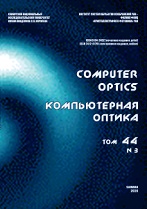|
This article is cited in 4 scientific papers (total in 4 papers)
IMAGE PROCESSING, PATTERN RECOGNITION
About quantifying small color differences in digital images
I. G. Pal'chikovaa, E. S. Smirnova, O. A. Barinovab, I. V. Latyshovc, V. A. Vasilievb, A. V. Kondakovb
a Technological Design Institute of Scientific Instrument Engineering SB RAS, 41, Russkaya str., Novosibirsk, 630058, Russia
b The Volgograd Academy of the Russian Internal Affairs Ministry,
130,Istoricheskaya str., Volgograd, 400075, Russia
c The Saint Petersburg University of the Russian Internal Affairs Ministry,
1, Pilot Pilyutov str., Saint Petersburg, 198206, Russia
Abstract:
We discuss aspects of the use and possibilities provided by three-color colorimeters or digital
cameras in problems of detecting small color differences by computer vision methods. The spectral dependence of the total color differences between pairs of visually indiscernible monochromatic stimuli is experimentally revealed. An experimental setup based on the UM-2 monochromator is created for producing a digital atlas of monochromatic stimuli at 1-nm increments.
The atlas serves to test the color gamut and color differentiation of cameras. It is experimentally
shown that in the visible spectral range a color difference of 3 units is detected by pairs of stimuli
that are unevenly distributed across the spectrum and differ in wavelengths from 1 to 6 nm. The
capabilities of computer vision are tested on the examples of identifying additional texts during a
technical and forensic examination of documents.
A new algorithm is developed for finding and quantitatively characterizing color difference of
inserts based on a digital image of the inscription. In the algorithm, the objective analysis of the
image is divided into a block of color segmentation and that of color tone and color difference assessment. With such an approach, the color segmentation block performs preprocessing functions,
making a border map for the classes with different colors for the subsequent calculations. The Otsu
method of optimal global threshold transformation is for the first time applied to a problem of image segmentation by color saturation. The trial of the algorithm confirms its efficiency in the solution of expert tasks.
Keywords:
digital camera color gamut, RGB sensor, color, monochromatic stimuli, dominant
wavelength, saturation, digital image processing, Otsu algorithm, segmentation, color difference.
Received: 12.09.2019
Accepted: 01.06.2020
Citation:
I. G. Pal'chikova, E. S. Smirnov, O. A. Barinova, I. V. Latyshov, V. A. Vasiliev, A. V. Kondakov, “About quantifying small color differences in digital images”, Computer Optics, 44:4 (2020), 606–617
Linking options:
https://www.mathnet.ru/eng/co827 https://www.mathnet.ru/eng/co/v44/i4/p606
|

|




 Contact us:
Contact us: Terms of Use
Terms of Use
 Registration to the website
Registration to the website Logotypes
Logotypes








 Citation in format
Citation in format 
